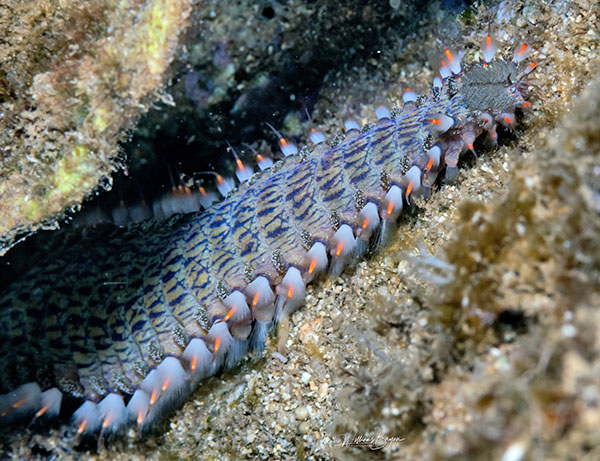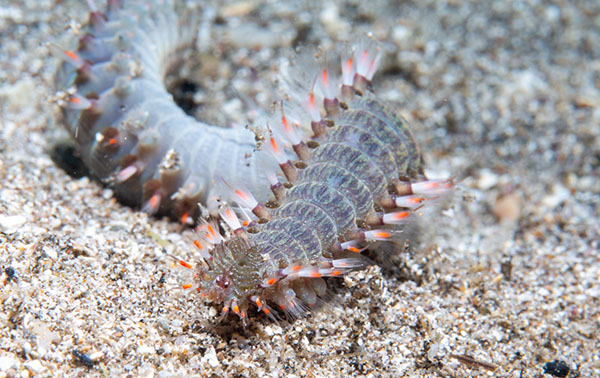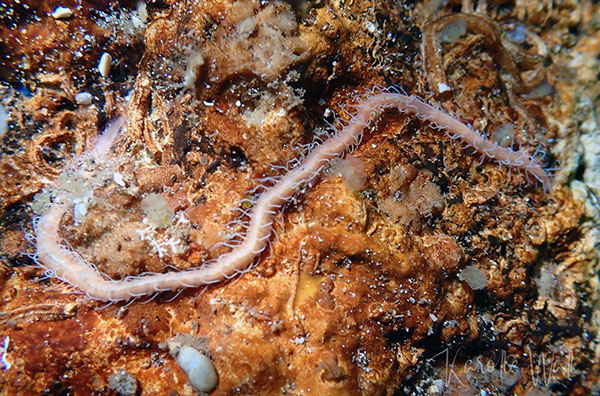 |
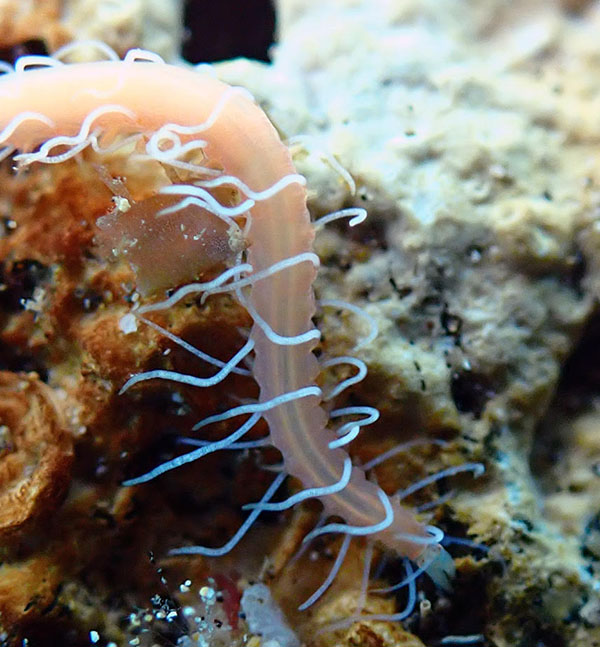 |
|
Family
Syllidae, subfamily Syllinae
Karolle Wall on Maui
writes: "I found this worm under a rock a fair ways outside
of the Kalepolepo fishpond today in about 3 metres of water. I’m
thinking it’s a Branchiosyllis cirropunctata, but there’s
something about the way it's segmented that doesn’t seem quite
right. Beautiful worm, but without the microscopic setting on my
camera I would never have seen the syllia. Approximately 75 mm though
not entirely sure as it was fast and hard to judge."
Karolle asked
polychaete specialist Leslie Harris whether her ID was correct.
Leslie replied “Nope. The species name cirropunctata
refers to black spots on the dorsal cirri. This doesn't have any
pigmentation. Subfamily Syllinae is as far as we can go from the
photo."
------------------------------------------------------------------------------
|
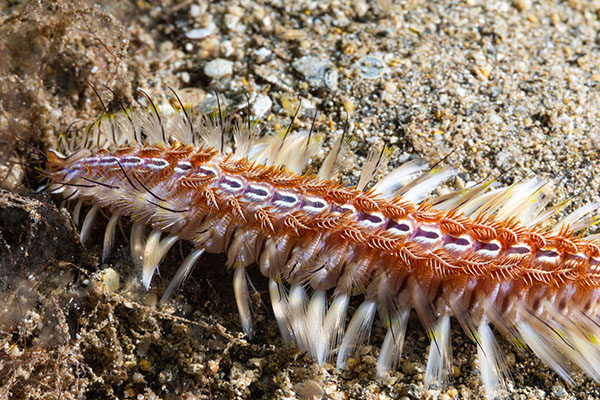 |
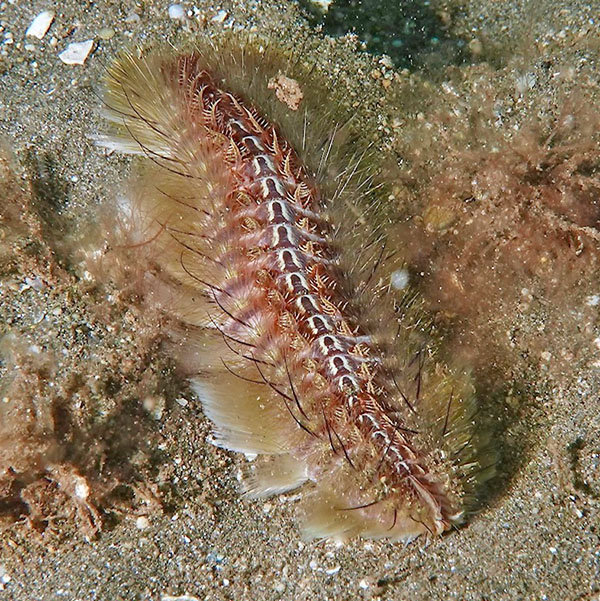 |
|
Chloeia
amphora
Kim Sakamoto found the upper
worm in July 2021 at the Curtiss Helldiver wreck off Sugar beach
on Maui, and Kevin Roe photographed it. The worm was about 3 inches
long and was active by day. The depth was about 55 ft. Kevin
sent the photos to polychaete worm specialist Leslie Harris, who
replied: "Your critter is Chloeia amphora. If you think
of the segmental markings as U's or V's the association with the
name amphora becomes clear."
Susan O'Shaughnessy and Pauline Fiene found the lower worm at Kealia,
Maui, in March 2023 at a depth of 26 ft. Susan photographed it.
It was also about 3 in. long. And in November 2023 Jonathan Goldberger
photographed another at night off Ulua Beach, Maui. So these worms
are definitely around, at least off Maui.
This species does not appear on the Bishop Museum list of polychaete
worms known from Hawai'i, so Kim's find might well be a first record
for the Islands.
------------------------------------------------------------------------------
|
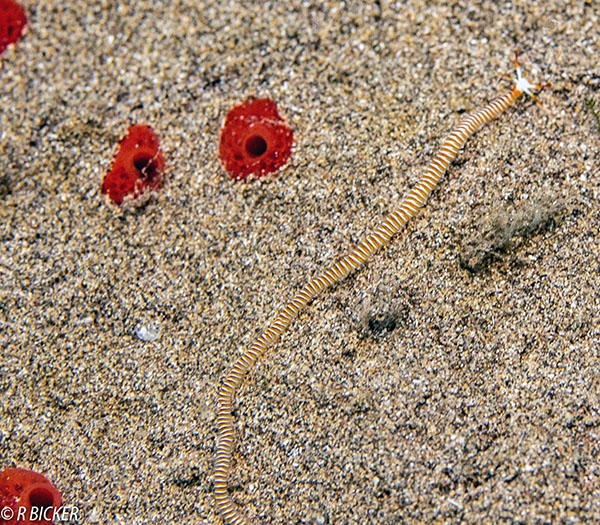 |
|
Unidentified
phyllodocid polychaete worm
Rebecca Bicker writes: "I
saw this worm on 8/6/20 at Kealia Pond area in Maui. I saw it on
top
of shallow reef at about 7 feet deep. Some surge in that spot."
She adds that it moved quickly and was about a foot long.
I did not know what it was, or even if it was a worm, because the
head tentacles resembled those of a synaptid sea cucumber. Cory
Pittman didn't know either, so he sent the photo to Gustav Paulay
at the Florida Museum of Natural History. Gustav replied: "It
is a phyllodocid polychaete. The head fits, and they often have
really gaudy coloration. They are long, thin worms."
Cory also sent the photo to polychaete worm specialist Leslie Harris
who replied:
The pigmentation of Rebecca's worm looks remarkably similar to ...
one
photographed in Moorea by Gustav's Biocode group. It is a phyllodocid
and could belong to one of several genera. If I could see the full
outline of the 3rd pair of tentacular cirri (the small pair hidden
behind the others just behind the head) I'd have a better idea of
genus
but I can't.
Interesting
to know that the same species seems to be in Hawaii. Since
there are only 2 photos of this I've no idea if it's native to the
ocean
around Moorea or to Hawaii or both. In my experience orange and
yellow
pigmentation in live phyllodocids turns brown or black when preserved.
If this is a described beast it was probably described from preserved
specimens which means we can't match it through literature descriptions.
If you ever get one please preserve it for me - I'd love to figure
it
out. If John can spread the word to his followers so they're on
the
look out for specimens as well that would be great.
More photos of this rare worm would be welcome!
------------------------------------------------------------------------------
|
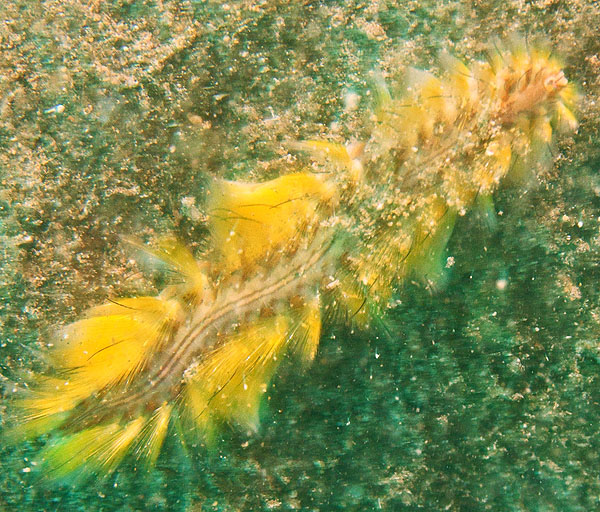 |
|
DARKLINED FIREWORM
Chloeia fusca
Ralph Turre found and photographed
this yellow worm off Sugar Beach, Kihei, Maui, in April 2014. It
corresponds well with photos of Chloeia fusca in Humann and
DeLoach's book Reef Creature Identification: Indo-Pacific.
According to the book, the bristles can be yellow, brownish, or
white, but the two parallel dark lines down the center of the worm
are diagnostic. The
similar Golden Fireworm, Chloeia flava, also occurs in Hawai`i.
Instead of parallel lines, it has a series of dark spots outlined
in white running down the center of the body. Both are widespread
Indo-Pacific species.
Below is another
photo of Chloeia fusca taken by Robert Johnson at Kawaihae,
Hawai'i. The ID was confirmed by polychaete worm specialist Leslie
Harris of the Natural History Museum of Los Angeles County.
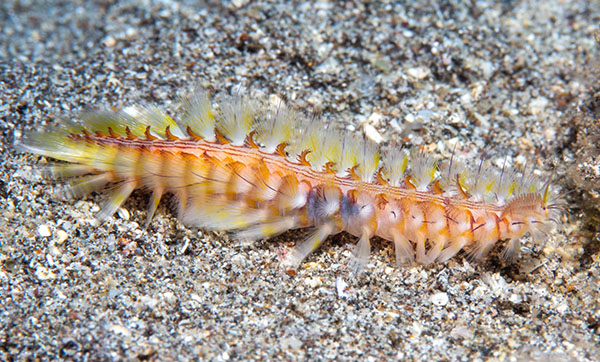
------------------------------------------------------------------------------
|
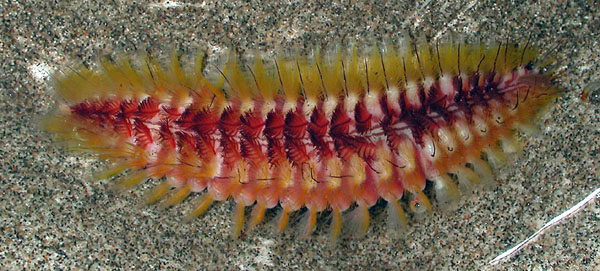 |
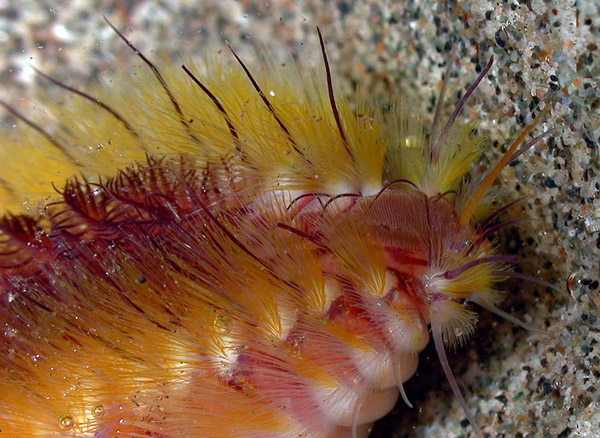 |
Chloeia
sp.
The worm in this photo was found
in 2006 by Darcy Kehler near Buzz's Wharf restaurant in Lahaina, Maui,
at night. Cory Pittman photographed it. Although it resembles the
worm above identified as Chloeia fusca, I wasn't at all sure,
so I sent the photos to polychaete worm specialist Leslie Harris.
Leslie says it is in the same genus but was unable to identify the
exact species. (Historical note: Leslie initially thought it was a
species of Notopygos and I posted it as such. Later she wrote:
"I was wrong about using the caruncle to separate Chloeia
& Notopygos. Much simpler & correct to use the branchiae
-- pinnate in Chloeia, arborescent in Notopygos.") |
|
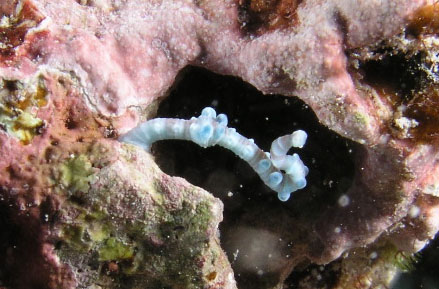
photo: Dick Lundholm
|
|
MARINE LEECH
1 Trachelobdella lubrica ?
Sharon
Williams found this animal at the dive site called Manta Ray Bay,
near Honokohau Harbor on the Kona coast of the Big Island. Dick
Lundholm took these photos. Dick reports that it was about 1 to
1 1/2 inches long and was curling and uncurling, extending itself
and contracting.
Leeches
are a type of segmented worm in the Phylum Annelida. (Bristle worms,
fireworms, Christmas tree worms, spaghetti worms, and earthworms
all belong in this group.) Leeches are distinct in that they have
a sucker at each end of the body. Most but not all are blood-suckers
which attach to other animals. This one was probably waiting for
a fish to swim by. Sharks in Hawaii often bear other species of
leeches on the gills or fins.
Leeches live in fresh water, in salt
water, and on land. At least 160 species are marine, most of which
occur in polar seas, or in cold temperate waters. At least 3 are
known so far from Hawai`i.
I
sent the photos to Dr Eugene M. Burreson of the Virginia Institute
of Marine Science, who replied: "The
large bulges on the side are called pulsatile vesicles. My guess
is that it is Trachelobdella lubrica, a leech that is fairly
common on the gills of tropical marine fishes (non-elasmobranchs),
and known from Hawaii. T. lubrica has large pulsatile vesicles
like the ones in the picture. I have examined specimens of it in
the Bishop Museum. There are few good photos of marine leeches in
their natural habitat, so it was a pleasure to see this one.
Pauline
Fiene adds "We have seen a different species on whitetips and
they move just like that."
|
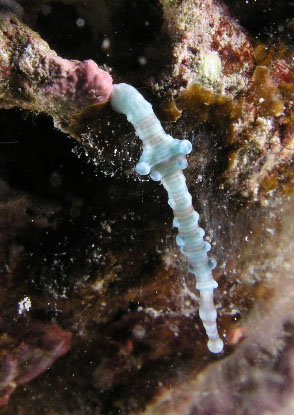
photo: Dick Lundholm |
|
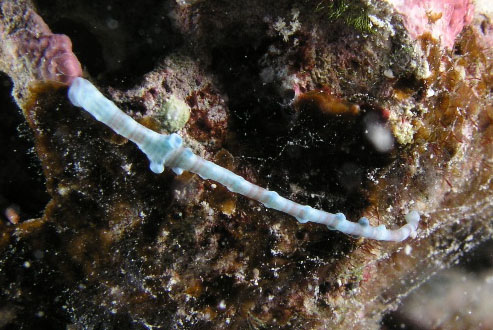
photo: Dick Lundholm
|

photo: Dick Lundholm |
|
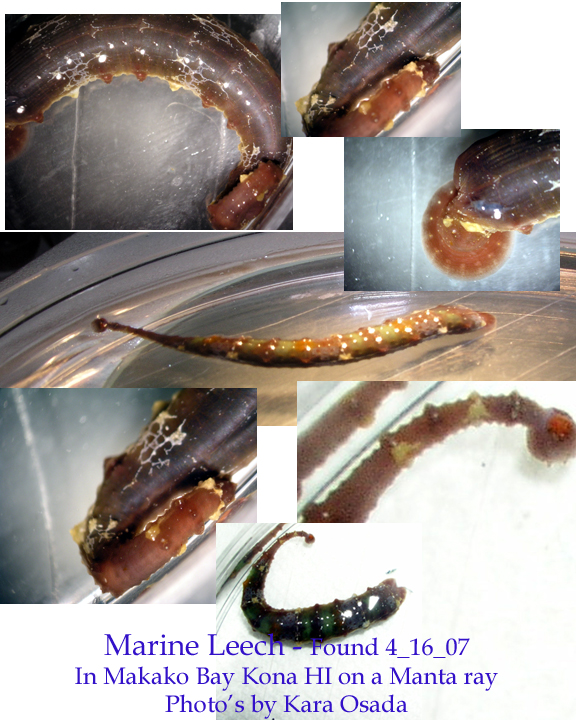
|
|
MARINE LEECH
2 Stibarobdella macrothela
Kara
Osada of Hilo sent me this photo collage of a leech which was removed
from a manta ray. Dr. Eugene M. Burreson writes: "Based
on the large orange ocular eyespot on the oral sucker in one of
the photos, the leech is likely Stibarobdella macrothela
Schmarda. This leech is relatively common on tropical sharks and
less common on rays. It is known from Hawaii." Subsequently,
Pauline Fiene sent me a couple more shots of the same species (the
bottom one taken by Warren Blum in Maalaea Bay, Maui). Dr. Burreson
writes: "The first picture is definitely
Stibarobdella macrothela because of the paired, large, orange
eyespots. My previous message to Kara may have suggested that there
is only one eyespot, because that's all I could see in her photo,
but they are definitely paired. The second leech is most probably
also S. macrothela, but I can't see the oral sucker very
well. It is interesting to get these photos of live leeches to see
the variation in color. Most specimens I have seen (rarely alive)
are greenish with white tubercles on some segments, but these seem
to be more purple. I have also seen them with orange pigmentation."
|
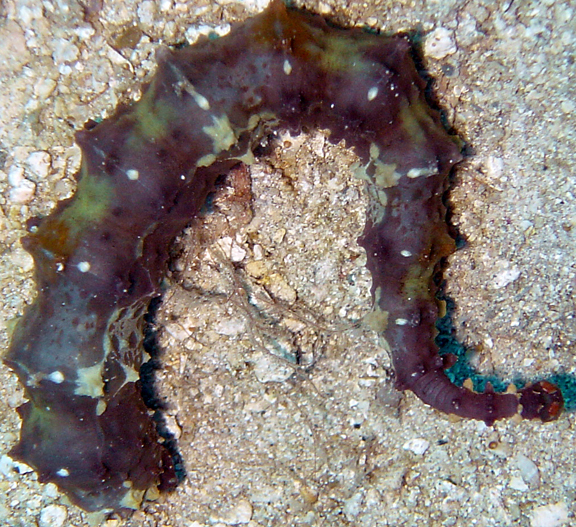
photo: Pauline Fiene |
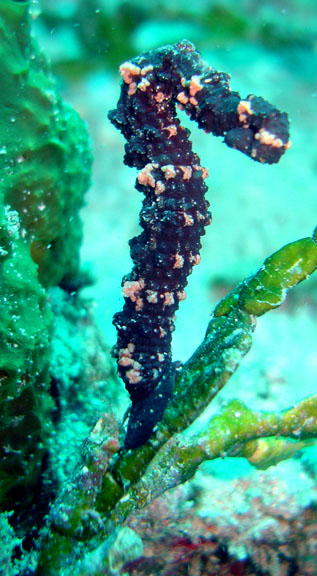
photo: Warren Blum |
|
